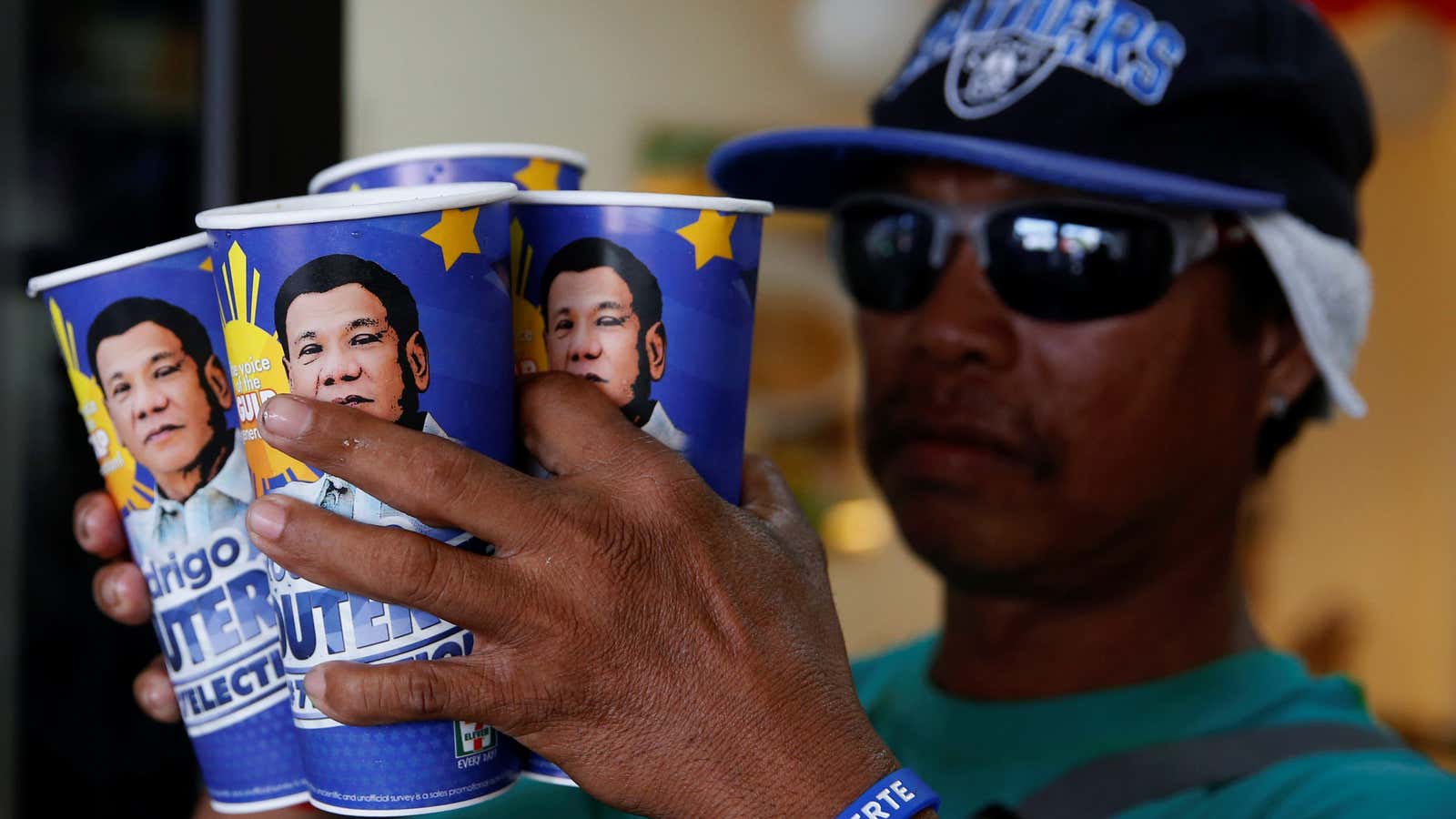In recent days, photos of Rodrigo Duterte’s oldest granddaughter, clad in an opulent, sparkling blood-red designer gown, have been making the rounds on social media in the country. The occasion: Isabelle Duterte’s photoshoot for her “debut,” the traditional 18th birthday celebration for girls in the Philippines. The venue for the shoot: the country’s presidential palace.
For many, the pictures of the “princess in the palace” couldn’t help but evoke a stark contrast with the average Filipino—the sort of person whose lot her grandfather vowed to improve in populist campaigning last year. Duterte himself came across as a provincial man of the people with his half-sleeved shirts and profanity. As the mayor of Davao City for more than two decades, he was known for a brutal crackdown on crime, and promised in his campaign to take that fight nationwide. After he won in a landslide, he served everyday fare such as plantain fritters and mongo bean soup at his presidential inauguration dinner.
The photos by contrast, were positively “Imeldific,” said some Filipinos, drawing parallels to Imelda Marcos, the widow of deceased dictator Ferdinand Marcos, who was reviled when it came to light in the 1980s that she owned more than 1,000 pairs of shoes. The photos come after a year that has seen thousands of deaths related to Duterte’s nationwide campaign against drug dealers, and in the wake of a battle against Islamic militants in the southern Philippines that has left Marawi City devastated.
Filipino novelist Miguel Syjuco decided to do some number-crunching on the clothes in the shoot, which led to a widely shared Facebook post. The red ball gown, for example, was custom-made by Dubai-based designer Garimon Roferos and shipped to Manila, according to the stylist on the shoot. Syjuco, a visiting professor at NYU Abu Dhabi, called Roferos’s studio and says he was told their dresses started at around the equivalent of 400,000 Philippine pesos ($7,900). This dress could be more due to the crystals and long train on it, he wrote. That’s about one-and-a-half times the average annual income for a Filipino family.
The photographer on the shoot, which took place last Thursday, soon rebutted Syjuco’s numbers, saying that the red dress had been “sponsored” by Davao designers now based in Dubai, the other dresses had been arranged by the stylist, and that most of the services for the shoot were also offered free. Still, despite the explanations, for many the overriding impression was of someone living beyond her family’s means.
“The public is sensitive to ostentatious displays of wealth, especially from politicians,” said Jean S. Encinas-Franco, an assistant professor of political science at the University of the Philippines, Diliman. “Persistent inequality shapes these perceptions. By being ‘one with the poor’ in terms of lifestyle, politicians are perceived to be ‘honest’ and not using the public coffers for their own benefit.”
Encinas-Franco said that she didn’t see long-term fallout for Duterte, however, noting that many critics of the shoot are “already against the President in the first place.”
Some of those critics raised legal concerns regarding parts of the shoot. In one of the photos at Malacañang Palace, Isabelle Duterte, who is due to turn 18 in January, is shown wearing a pale pink gown before the presidential seal, raising questions about whether this could be a violation of a law dictating how the symbol is to be used. A story about the photo shoot noted that past photo ops at the presidential palace have generally involved official events and press conferences. Presidential spokesman Harry Roque said that he didn’t believe there had been any legal violation.
Isabelle Duterte, whose father is Paolo Duterte, the president’s oldest son and vice mayor of Davao, didn’t immediately respond to a query sent via Facebook, where she posted some of the photos to admiring comments. Last week, around the time her own photos were making the rounds, she also posted a photo of Imelda Marcos in 1979 dressed as a bride to mark her 25th wedding anniversary at the presidential palace.
It’s possible the Duterte family may not consider the comparison to the Marcos family to be all that insulting. Duterte has made efforts to restore some measure of honor to Marcos, who was toppled in a peaceful “People Power” revolution and went into exile with his wife in 1986. Philippine investigators estimated at the time they had amassed $10 billion in wealth. But last year, Marcos’s body was brought back to the Philippines and quietly buried in a cemetery reserved for national heroes—a privilege that many thought should not have been accorded to a leader known for systemic human rights abuses.
As for his widow, now in her late eighties, she returned to the Philippines in 1991 after her husband’s death. She was convicted in 1993 of corruption in relation to her husband’s time in power, and faced a 12-year prison sentence, but didn’t end up serving time after her conviction was overturned in 1998. She ran successfully for congress, at one time serving as chair for a congressional committee overseeing implementation of the UN’s Millennium Development Goals for the Philippines. She is still serving after winning in elections last year.
Rodrigo Duterte, when asked about his granddaughter’s shoot on Sunday, called it a “small matter.”
This piece was updated on Dec. 19 with comments from political scientist Jean S. Encinas-Franco.
